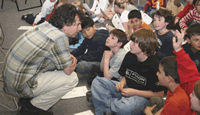
Why Math + Code? A Look at the Past, Present and Future
This is a three part Interview with George Gadandis, Professor at Western University’s Faculty of Education. Dr Gadanidis considers how coding is used to teach math concepts today and what we can do to enhance math understanding through coding in the future. He also provides the run-down of past initiatives, including the works of Seymour Papert and the programming language LOGO.
Math + Code: Today
|
PRESENT Digital technology is all around us – in our phones, apps, tablets, kitchen appliances, cars and so on – we all use digital technology but few of us can edit it or create with it. Coding, also known as “computer programming,” is the process used to create and control the digital technology around us. What do you think? Should children learn to code from a young age? |
Math + Code: In the Past
|
PAST The most prominent coding movement of the past was based on Seymour Papert’s Logo. In Logo, children use code to move a “turtle” on the screen, which can leave a trail of the path it travels. Papert developed Logo as a mathematics learning environment. Papert also developed Logo to challenge beliefs about who can understand what and at what age. |
Math + Code: Future
|
FUTURE Today, unlike Papert’s work in combining Logo with mathematics, the focus on coding is mostly as its own curriculum. Some integration of mathematics and coding has benefits: (1) it helps address the issue of a crowded curriculum; (2) it provides a meaningful context for learning to code; (3) the modelling of mathematical concepts made possible through coding can enhance understanding; and (4) mathematics and coding share a similar logical structure, with a common focus on computational thinking. |
